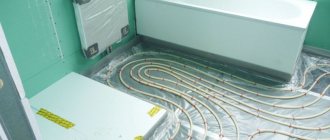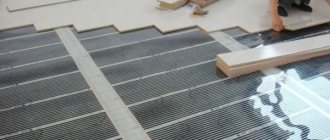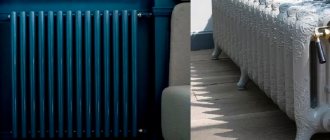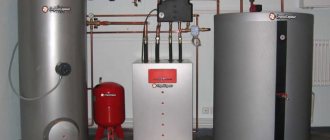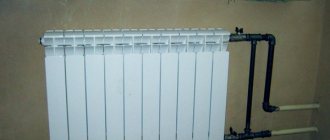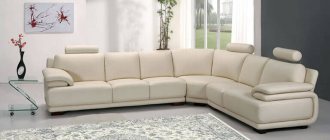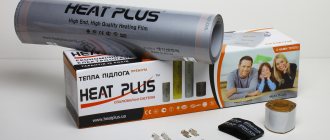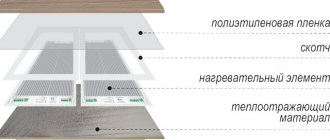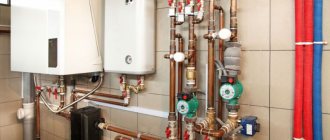Heating private houses and apartments using water heated floors is a fairly popular option, since the system is efficient and economical. Warm air rises evenly from bottom to top, creating optimal indoor comfort. Warm floors can be implemented in different ways; it can be a warm floor from central heating in an apartment or an electric one, which requires laying a heating cable. Considering the cost of electricity, many residents find the idea of installing radiator-powered floor heating in their apartment more attractive. Costs will mainly be on equipment, and heating costs will not be so high.
Is it legal to connect to a centralized heating system?
It is a common belief that connecting a heated floor to hot water in an apartment or a heating radiator is strictly prohibited. This is not entirely true. Permission can be obtained from the management company if the apartment is located at the end of the heating circuit - on the first or last floor, depending on the heat supply scheme. Thus, the thermal energy received in the apartment will not harm other residents in the apartment building. As a rule, you need to install a thermal energy meter, and you can safely connect the heated floor from the battery.
Heat energy is supplied through a heat exchanger for the heated floor in the apartment, which makes it possible to make the heated floor circuit “autonomous”, not affecting other heat consumers.
How will the height of the room change due to the installation of heated floors?
When planning to install underfloor heating in an apartment, you need to think about not only the costs of materials and obtaining permission. An important nuance is to take into account how the floor height will rise. It is necessary to install good thermal insulation on the subfloor so that the heat does not escape into the floor slabs. For apartments on the second and higher floors, it is enough to lay 3 cm of insulation (polystyrene, etc.).
If the heated floor in the bathroom from the heated towel rail is connected on the first floor, below which there is a basement or ground, the insulation layer should be within 5-10cm. Next, the size of the pipes and the layer of finishing coating are taken into account. The result is the final figure by which the height of the room will be reduced. If living space allows, you can buy equipment.
Pipes for heated floors
Considering that water floor heating is filled with screed, it is clear that you need to choose durable pipes. The choice of a specific material will directly affect what the price of 1 sq. m of warm water floors will be.
But the price is not the main thing, it is important to comply with the conditions:
- It is not allowed to use seamed pipes; they may burst if the pressure increases. The same applies to a large number of joints in the heated floor circuit - this is a potential cause of blockages and leaks.
- We need strong pipes that can withstand coolant pressure, the severity of the screed, and dynamic loads (the guideline is pressure resistance of at least 8 bar).
- High levels of resistance of pipes to corrosion, chemicals, scale, as well as sound insulation (so as not to hear noise from water movement) are important.
- The diameter of the pipes varies between 16-20mm (too thin pipes will increase the pressure, thick pipes will increase heat loss in the overall heating system). Before connecting a heated floor to an existing heating system, it is worth considering the availability of adapters and fittings of suitable sizes.
What do you need to connect a heated floor?
You can’t just cut the contours of a heated floor into the heating risers. The water will not circulate on its own, so you will need a pump. A system is also needed to remove air that accumulates in the system. The coolant in central heating is not clean, so to protect your own floor heating system you need to install filters that trap dirt particles.
It is important to take into account that the coolant in centralized heating can be heated up to 80 degrees, and you cannot run such water into your system - this will ruin both the screed and the finishing coating, and the room will be excessively hot.
The optimal coolant temperature in a heated floor system is up to 45 degrees.
Therefore, it is necessary to install a unit that mixes water from the supply and return, as well as devices that control the parameters. Therefore, the price of a heated floor will include the price of a thermal sensor for a heated floor, a thermal head, a servo drive, etc.
Radiator heating
Radiator heating is traditionally installed in city apartments. It is effective and reliable. Heating devices are in plain sight, allowing for quick repair work.
Manufacturers offer radiators of various modifications to suit any room design. If necessary, use protective panels to hide batteries. What are the advantages and disadvantages of radiator heating?
- The air heats up quickly, which is important for cottages that are not used every day.
- Any covering can be laid on the floor, including wood, laminate or parquet. Overheating is undesirable for cladding made of wood. The material is warm and has low thermal conductivity. It is not recommended to install wood cladding for underfloor heating. Laminate or parquet floors do not transfer heat well.
- If the floor is not insulated well enough, then radiator heating will be the optimal solution.
Along with the positive characteristics, heating has some disadvantages. Heat from heating devices rises. The temperature on the floor is lower than in the ceiling area. Carpets and carpets are used to insulate the floor.
We recommend: How to install heated floors under PVC?
Warm air from radiators causes turbulence that raises dust in the room, which is undesirable for allergy sufferers. Batteries dry out the air a lot. To maintain normal indoor humidity at 55%, humidifiers are installed.
Radiator heating involves 2 schemes: one-pipe and two-pipe. The single-pipe system is called “Leningradka”. Hot and cooled coolant circulate through one pipe. "Leningradka" is intended for heating small houses, with 3-5 radiators. The latest appliances do not heat up well enough.
With a two-pipe system, hot and cooled water circulate in separate pipes. The batteries are connected to the return circuit via bypasses. A two-pipe system can be installed in large houses, with up to 8-10 radiators.
The pipeline is led from the boiler. The coolant temperature reaches 95 0C. The normal thermal regime of batteries is 80 0C.
To increase the speed of movement of hot and cold water along the circuits, a circulation pump is installed. It is connected to the return pipe. It pumps coolant into the boiler. A sump tank, an air tube and an expansion tank are installed in front of the pump. Some of the liquid enters it; the pressure in the pipes is maintained.
In small houses, a circulation pump is not installed. The pipeline is laid at an angle. The supply circuit is located at an angle to the radiators. The coolant enters the batteries under the influence of gravity. Cooled water is returned through the main line, which is inclined towards the boiler.
If you connect a heated floor to one of the radiators, the amount of hot water will decrease. Other appliances will not heat up well enough. It is necessary to calculate the heating system. Usually the boiler power is increased.
It is recommended to install a floor main from the last battery in private houses. The “warm floor” is connected to the return pipe. The temperature of the coolant in it is 45 0C. This is the optimal thermal mode for water underfloor heating.
Heated floor connection diagram
To properly connect the selected system, you need to prepare the equipment: circulation pump, servo drive for the heated water floor collector, temperature control sensor, distribution unit, collector. Connection and test run of the system are carried out before pouring the screed.
The main thing in the system is the distribution unit; it regulates the temperature of the coolant.
Thanks to a three-way valve and sensor (thermal head for underfloor heating), the apartment owner regulates the temperature, achieving optimal comfort and saving on bills. The essence of the operation of the valve with the sensor is to timely shut off the hot flow when the set temperature is exceeded.
A circulation pump is needed for uniform distribution of coolant in the system. The pump is installed after the distribution unit, but after the manifold group. From the three-way valve, cooled water flows into the pump, then into the manifold and along the contours of the heated floor. An air vent and a drain valve are installed in the upper and lower parts of the collector, respectively.
The diagram shows how to connect a warm floor to heating in apartments that close the heating circuit. If the insertion is carried out in apartments in the middle, then the three-way valve is replaced with a two-way valve.
Alternative underfloor heating Xl Pipe
Those who do not have the opportunity to legally connect floor heating from a battery should familiarize themselves with the modern Xl Pipe system. Reading reviews of xl Pipe underfloor heating, they note that this is a kind of hybrid of electric and water heating that does not have their disadvantages. The heating element here is a polyethylene tube with a diameter of 2 cm, filled with antifreeze. Inside the tube is a chrome-nickel heating cable in a Teflon sheath.
The design is sealed and safe. The system does not use a pump, manifold, or boiler. The coolant does not move here. Installation of liquid electric heated floor Xl Pipe is carried out in a screed. Furniture and equipment can be moved without restrictions, the system will not be damaged. As reviews of underfloor heating as the main heating say, this option copes with the task quite well; the temperature can be adjusted at your discretion.
The essence of Xl Pipe's work is simple and clear. When turned on, the cable begins to heat the coolant, quickly reaching the set temperature. The fluid pressure in the system ensures uniform heat distribution. According to the manufacturer, such a warm floor consumes one third less electricity compared to other electric heating systems. When compared with water heated floors, the costs of purchasing a boiler, manifold and other equipment are eliminated.
Floor heating with infrared film Heat Life
Those who have no idea how to properly make a heated floor from heating, or do not have the opportunity to carry out major renovations in the room to do this, should take a closer look at the Heat Life IR heating film. It can be used as a main or additional heating system in offices, residential buildings, industrial and other facilities. Those who choose Heat Life heated floors note minimal installation and maintenance costs and low heating bills.
As a rule, installing the film does not require filling the screed. It can be used to heat tiles, linoleum, laminate, porcelain stoneware, and other flooring options. Energy is used to heat the floor, not the air. In addition, infrared film can heat any surface - vertical, inclined, embossed. Even if a section of the film is mechanically damaged, the overall system will continue to work. Corrosion is not a problem for Heat Life film.
Connecting a “warm floor” to a battery
The floor line is connected to the supply or return circuit. This installation can be carried out in city apartments only with the permission of government authorities, therefore such schemes are used only in private cottages.
- If there is one radiator installed in the room, then a separate circuit is connected to the “warm floor” from above it. A filter, an air tube and a circulation pump are installed on the pipe. It pumps coolant into the water main.
- The other end of the line is connected to the radiator from below. The cooled coolant is discharged from the battery through the return pipe to the boiler.
- The circulation pump is equipped with a thermal head or servo drive. When the water temperature in the floor circuit increases, the pump stops working. Heating stops. Only radiator heating is operational.
It is possible to connect a “warm floor” from a battery using a different scheme, to the return pipeline. A bypass is provided for hot and chilled water. Install automatic temperature control for the floor.
- Remove the loop from the return pipe.
- A three-way valve, with a thermal head, and a circulation pump are installed on it.
- A floor line is removed from the pump.
- The other end of the pipe is connected via a bypass to the heating return circuit. Cooled water passes through it to the boiler. The distance between the supply and return connections should not be less than 30 cm.
- A two-way valve with a thermal head is installed on the bypass. When the temperature in the floor line rises, the valve shuts off the outlet of cold liquid to the boiler. Through the bypass it flows to a three-way valve, where it is mixed with the hot coolant.
- When the thermal conditions are normalized, the two-way valve opens the outlet for chilled water. She goes back into the furnace.
We recommend: How to install water-heated floors?
The connection of the “warm floor” to the battery must be carefully calculated. When installing a high-power boiler, the floor temperature may be higher than normal. It will be impossible to walk on it. For each room, an automatic system is installed that regulates the thermal regime.
YouTube responded with an error: The request cannot be completed because you have exceeded your quota.
- Related Posts
- How to calculate the distance between underfloor heating pipes?
- How to calculate the power of a heated floor?
- Features of Korean heated floors
- How to lay a water-heated floor under tiles?
- What kind of warm floor can be laid under a carpet?
- Pros and cons of heated floors
Advantages and disadvantages of heated floors
Among the advantages of using water and electric underfloor heating systems, savings on heating bills are noted. If your feet are warm, even the minimum temperature can be perceived as comfortable. Installation is not complicated, the appearance does not attract attention like standard heating radiators. There will be no drafts in a house with heated floors. Children will not get cold playing on the floor.
As for the shortcomings, there are them too. Firstly, these are the costs of equipment and installation. Secondly, water heated floors require a loss of several centimeters from the height of the room. Thirdly, the floors must be free of carpets - otherwise, why heat them. When a breakdown occurs, it is difficult to determine which area is damaged. Furniture should not cover the floor so as not to interfere with heat circulation.
Having familiarized yourself with all the listed nuances, you can make an informed conclusion about heated floors and the advisability of using them in an apartment as the main or additional source of heat. In general, electric floor heating systems are installed in small rooms - in the bathroom, kitchen, toilet. If you plan to heat a spacious room, it is better to give preference to a water-based system. In any case, it is important to consult with professionals; they will subsequently be entrusted with the installation of the system, startup and maintenance. This way you can get guarantees for the safety and durability of the system.
Underfloor heating
The “warm floor” heating system is installed quickly. If plastic pipes are used, installation takes place in a few hours. During operation, a lot of dirt does not form. The system has its advantages.
- Efficient room heating. Warm air rises from the floor covering and from interior items. The temperature on the floor is higher than near the ceiling. There is no need to lay carpets or wear warm house shoes.
- There are no air turbulences, dust does not rise, and for people who suffer from bronchial diseases, a “warm floor” is a more favorable heating system.
- The floor temperature does not exceed 25 0C. Air humidity remains normal.
- No radiators in the room.
Among the disadvantages of an underfloor heating system is the prolonged heating of the room. The liquid line is hidden in the screed. If there are leaks, it will be difficult to carry out repair work.
However, underfloor heating is used both as a main and additional means of heating. The owner of the cottage independently decides which system to choose, warm floors or radiators.
We recommend: What characterizes Rehau underfloor heating?
The floor water line is removed from the boiler. The circuit is connected to the supply and return manifolds. The comb is connected to the outlets in the boiler.
A circulation pump with three-way or two-way valves is connected to the return circuit. They are equipped with thermostats with temperature sensors. The heating system operates automatically.

